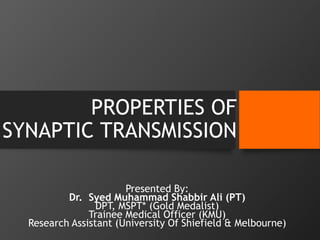
Nervous system lec 2.pptx
- 1. PROPERTIES OF SYNAPTIC TRANSMISSION Presented By: Dr. Syed Muhammad Shabbir Ali (PT) DPT, MSPT* (Gold Medalist) Trainee Medical Officer (KMU) Research Assistant (University Of Shiefield & Melbourne)
- 2. SYNAPSE: Definition: Synapse is the junction between two communicating neurons. Classification: 1. Anatomical classification 2. Functional classification
- 4. 1. Anatomical classification: • Synapse is formed by axon of one neuron ending on the cell body, dendrite or axon of the next neuron. • axodendritic, axosomatic, and axoaxonic synapses.
- 6. 2. Functional classification: i. Electrical synapse ii. Chemical synapse i. Electrical synapse: In this type of synapse the physiological continuity between presynaptic and postsynaptic neurons is provided by gap junction between the two neurons.
- 8. • ii. Chemical synapse: It is the junction between two fibers, through which the signals are transmitted by the release neurotransmitter.
- 9. SYNAPTIC TRANSMISSION: The process by which the impulse in the presynaptic neuron is transmitted across the synaptic cleft to the postsynaptic neuron is called synaptic transmission.
- 12. PROPERTIES OF SYNAPTIC TRANSMISSION: • One way conduction at chemical synapses • Synaptic delay • Fatigue of synaptic transmission • Summation • Electrical property
- 13. One way conduction at chemical synapses : • One way conduction means the impulses are transmitted only in one direction (from presynaptic neuron to postsynaptic neuron).
- 14. Synaptic delay: • It is a short delay (0.5 ms) that occurs during the transmission of impulses through the synapse. It is due to the time taken for: • i. Release of neurotransmitter • ii. Diffusion of neurotransmitter from axon terminal to postsynaptic membrane • iii. Action of neurotransmitter on the receptor
- 16. Fatigue of synaptic transmission: • During continuous muscular activity, synapse becomes fatigue. Fatigue of synapse is due to the depletion of neurotransmitter substance, acetylcholine. Depletion of ach occurs because of two factors: • i. soon after the action, ach is destroyed by acetylcholinesterase • ii. Due to continuous action, new ach is not synthesized
- 17. Summation: • Summation is the fusion of effects or increase in the excitatory postsynaptic potential in postsynaptic neuron. • Summation is of two types: • i. Spatial summation • ii. Temporal summation
- 19. i. Spatial summation: Spatial summation occurs when many presynaptic terminals are stimulated simultaneously. ii. Temporal summation: Temporal summation occurs when one presynaptic terminal is stimulated repeatedly.
- 20. Electrical property: • Electrical properties of the synapse are the: ESPS (Excitatory Postsynaptic Potential) ISPS ( Inhibitory Postsynaptic Potential) The postsynaptic receptors allow positively or negatively charged ions into the next cell. The charge in the postsynaptic neuron resulting from this is called the postsynaptic potential. The neurotransmitters are like the reward or consequence we give our child. The reward is like a neurotransmitter that causes positive ions to enter the postsynaptic cell, and the punishment is like a neurotransmitter that causes negative ions to enter the cell.
- 24. ESPS (Excitatory Postsynaptic Potential): • Excitatory postsynaptic potential(EPSP) is a postsynaptic potential that makes the post synaptic neuron more likely to fire an action potential. It is a depolarizing graded potential of the postsynaptic membrane.
- 25. ISPS ( Inhibitory Postsynaptic Potential): • If the post synaptic potential makes the postsynaptic neuron more negative, it is called an inhibitory postsynaptic potential. • ISPS is a hyperpolarizing graded potential of the postsynaptic membrane.
- 26. Effect of Acidosis or Alkalosis on Synaptic Transmission: • Alkalosis greatly increases neuronal excitability. For example, a rise in arterial blood pH 7.8 to 8.0 often causes cerebral epileptic seizures because of increased excitability of some or all of the cerebral neurons • Acidosis greatly depresses neuronal activity; a fall in pH from 7.4 to below 7.0 usually causes a comatose state.
- 27. Effect of Hypoxia on Synaptic Transmission: • Neuronal excitability is also highly dependent on an adequate supply of oxygen. Cessation of oxygen for only a few seconds can cause complete inexcitability of some neurons.
- 28. Effect of Drugs on Synaptic Transmission: • Caffeine, theophylline, and theobromine, Strychnine increase excitability of neurons. • Anesthetic drugs decrease excitability of neurons.
Notes de l'éditeur
- Basis of mode of impulse transmission
- Significance of synaptic inhibition